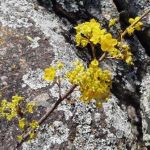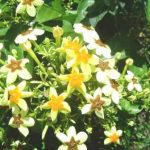TREE LIFE
May 1983.
MASHONALAND CALENDAR
Saturday April 30th : Learner’s Group. Gill Masterson will take a small party of beginners to an area of bush in or near town. Those new to identifying trees and indeed those with more experience will benefit from Gill’s vast fund of knowledge so this is well worth supporting. Those who would like to attend should hone Gill direct at 303435 to arrange time and R.V. point.
Saturday May 7th : Botanic Garden walk. Meet in the Car Park at 0845 for 0900 hours.
Sunday May 15th : Botanic Garden Extension, Mazowe Road. This will be a brand new experience for a lot of us and promises to be exciting. We hope to persuade Tom Muller or Bob Drummond or both to come along and make the visit that much more meaningful.
A bus has been arranged which will leave Monomotapa Car Park at 0900 hours. Fare $6.50.
Saturday May 21st : Binga Swamp Forest. A supplementary on our calendar. Dick Petheram, our past Chairman, who does so much to preserve this unique forest, has appealed for help in removing Mauritius Thorn seedlings which are a constant threat to the forest. So we settled on this date to pull seedling and also get educated on the forest and surrounds by Dick. You are invited to come, morning, afternoon, or both, and have your picnic in the forest. If you wish to bring a labourer, so much the better. Time, any time after 0930 hours in your own vehicle.
BOTANIC GARDEN WALK 5TH APRIL, 1983
As mentioned in the last newsletter, this month’s garden walk was to be a continuation of the RUBIACEAE. Last time we covered 22 species in the allotted time; this time we managed little over half that number due to the walking involved. The garden is laid out ecologically rather than in families, so we tended to dash from one ecotype to another.
Last time we looked at two species of Gardenia which both had a very restricted distribution. Both occur in forests of the Eastern districts. This time we turned attention to the more common woodland species.
Gardenia resiniflua is very much a lowveld species, occurring in low rainfall areas though often along rivers. It is a small flowered and small fruited species, and the leaves are usually hairy, particularly on the under surface. The veins are sunken from the upper view of the leaf, giving a “quilted” appearance. The plant was in young fruit and we were able to note again some of the ‘gardenia features’ namely the inferior ovary and the leaves in groups of 3. Of course the 3-leaf grouping was seen in Rothmannia as well. However, it was by no means clear, just by examination, of the origin of the spare leaf. The issue was further confused by the stipules which appeared to be at the base of the petioles rather than interpetiolar. The stipules surround the stem, just joined for much of their length and being generally persistent.
Nearby was G. volkensii (formerly spatulifolia) the common gardenia. It has a very wide distribution in woodland, and Tom believes it to be flood resistant as he had seen it in the Okavango standing in water looking very happy. Leaves are markedly bunched on lateral spurs, and are generally glabrous in contrast to those of G. resiniflua. The old name was most appropriate from the descriptive point of view, as the leaves to tend to a spatulate shape at the apex. When in flower and fruit G. volkensii is unmistakable; it has larger flowers than the other woodland species G. ternifolia (jovis tonantis of former days) to which we now turned our attention. At first glance it may seem difficult to easily distinguish this from G. volkensii. The leaves are less spatulate, but then, leaf shapes are notoriously variable, so closer examination was required. Apart from difference in shape, the leaves of G. ternifolia are generally larger, and furry on the under surface; further, the top leaf surface tends to feel abrasive in contrast to G. volkensii. However, the bark is the most distinctive feature of contrast. G. volkensii has a very smooth looking bark as does ternifolia, but that of the latter is rusty looking and a rusty coloured powder can be rubbed off.
In terms of a rough roadside identification, G. ternifolia tends to have longer branches and a less “bushy” and dense appearance.
Turning from the Gardenias we were quick to note the several bright red patches among the other trees. These were, of course, Hymenodictyon floribundum, the ‘firebush’ so characteristic of granite kopjes. This year the second successive drought year, many trees are showing signs of distress, even in ‘captivity’. The leaves of the fire bushes were shriveling at the same time as taking on their autumn shades and all the strange tiny leaves usually seen on this species had gone.
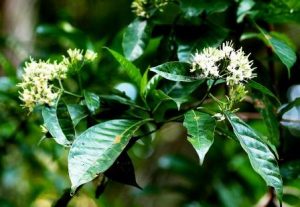
Tarrenna pavettoides. Photo: Bart Wursten. Source: Flora of Zimbabwe
Tarenna neurophylla was also looking stressed if compared with Hymenodictyon. However, this evergreen tree of granite kopjes always has this rather droopy wilted look. Despite the lack of water, stipules remain green and succulent looking in this species. They are very pointed at the free end.
There are several other species of Tarenna in Zimbabwe, but they do not show this same dropping tendency. One is an inhabitant of the forest edge in parts of the eastern districts, e.g. Burma Valley, Tarenna pavettoides. The genus has undergone some revision, and now includes a plant which has changed both its generic and specific names, an usual event in Botanical Nomenclature – namely Tarenna zimbabwensis (formerly Enterospermum rhodesiacum). It is a species of eastern and south eastern distribution, occurring amongst boulders at the forest edge. It is distinguished by the flattened leaf bud and broad stipules.
There are 5 species of Tricalysia (of tree form at least) in Zimbabwe. Last time we looked at T. jasminiflora, and this time we came across T. angolensis, a more woodland species, also occurring on top of rocky kopjes. The only feature of note at this time of year was the soft velvety feel of the leaves, though of course, the genus Tracalysia is known for its profuse and sweet smelling flowers at other times.
Tom found us a Psychotria kirkii to compare with 2 species we examined last time. This species is never more than a shrub and occurs in shady spots in woodland and rocky places, not in evergreen forest as do the other species of this genus. Even so, the lack of water was affecting this specimen, and it was attempting to flower and fruit out of season, frequently a sign of stress. The few surviving leaves clearly showed the dots of bacteria like the other species we saw last time.
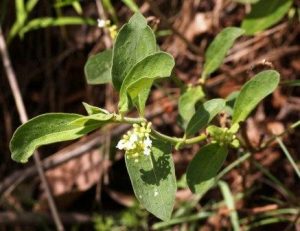
Rothmannia fischeri, Photo: Meg Coates Palgrave. Source: Flora of Zimbabwe
We came across Rothmannia fischeri, a woodland species unlike most of the other Rothmannias which are forest edge dwellers. It however retains the evergreen habit, probably by inhabiting more rocky areas where water may be trapped. As is typical of Rothmannia in gardens R. fischeri had both old and green fruit at the same time. The fruit takes 2 years to ripen, but new flowers and fruit are produced each year, hence the different stages of fruit on any one plant. R. manganjae which we examined last time showed several other characters in common with the woodland rothmannia, namely the leaves appearing to occur in threes, particularly where branching occurs, though this is due to the development of one axial bud into a single leaf, while the other becomes a branch.
Oxyanthus was next on the list. The specimen was marked Oxyanthus oxycarpus which does not occur in the tree books, so I suspect that it must be O. speciosus suffering a name change. Anyhow, by whichever name it goes, this specimen came from the Mount Selinda Forest where it usually forms part of the understory. The stipules are very large and strong, and the leaves tend to lie in one plain.
With the light fading rapidly we briefly glimpsed Craterispermum schweinfurthii, a shrubby species which tends to rapidly colonize disturbed areas of low altitude forest, i.e. old cultivated fields. Despite this pioneering tendency Tom has found if very difficult to cultivate in the garden. Another challenge of nature for us to try to solve.
On our way back we noted Ixora narcissodora, red trumpets, unfortunately not in flower. It is a species of deep shade in low altitude forest.
Thank you Tom for another informative walk. Most of which probably never see many of the species in the wild, and we look forward to the continuing saga of the RUBIACEAE next month.
Please remember the meeting is in the morning for the winter months.
OUTING TO CALEDONIA FARM 17TH APRIL 1983
Sunday 17th April found the Harare branch converging on Caledonia Farm, the home for many years of Bob and Val Laing. After meeting our hosts at the homestead and rendezvousing with the motor car arrivals, the bus took us to an area a few kilometers away where a bouncy track wound its way through a miombo woodland to a stream with a rocky bed where we focused our attention.
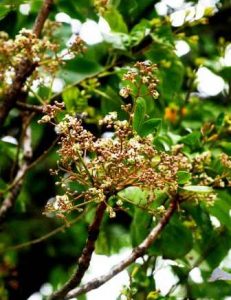
Ekebergia benguelensis. Photo: Bart Wursten. Source: Flora of Zimbabwe
On alighting from the bus we immediately encountered Ekebergia benguelensis and soon after, were able to compare it with Lannea discolor which it superficially resembles both in leaf colour and because the leaves in both species grow terminally from the branchlets. However the obvious difference was that the former usually has a red or pink petiole and leaf rachis and also a reddish appearance on the branchlets themselves. This colouring is absent in Lannea. Also, Lannea is typically ‘discolored’ meaning that the lower leaf surface is much paler than the upper surface.
Moving on we were able again to make a comparison as we had done a month previously at Marsala Farm, between Protea welwitchii and P. gaguedi, the former having velvety, olive green leaves and having flowers in clusters, and the latter having less hairy, blue-green leaves and flowering singly. Later, on our afternoon walk, we were able to complete the trio of Proteas we see in our area, when we saw P. angolensis showing much rounder leaves with a pink base to the sessile leaf – i.e. no petiole as such.
Moving into the stream bed itself we saw a good specimen of Diospyros lycioides in fruit and at its feet, the ground creeping Ficus verruculosa in its favoured riverine habitat. Very close by but in a very atypical habitat, was a very small specimen of F. sur (ex. capensis) yet still showing its typical habitat of fruiting on the trunk and main branches.
We then saw Rhamnus prinoides (family RHAMNACEAE, in which we also find Ziziphus) in green and red fruit. This is not a tree we see often, so it was pleasing to see it showing the beautifully shiny leaves with prominent veining on the undersurface and recessed veining on the upper surface. This is a riverine tree, also found in evergreen forest. This tree is so pleasing to the eye and so easily grown that it is a realistic possibility for a garden
Close by were a number of medium sized Bequaertiodendron magalismontanum also trees favouring stream banks, showing the dark green glossy surface on the upper side of the leaf, and , in contrast, the paler, matt, rusty looking undersurface.
Further down the rocky stream bed and below a truly enormous Hamerkop’s nest was a sizeable specimen of (family CLUSIACEAE where Hypericum and Psorospermum also belong) with opposite leaves and its characteristic feathery veining which is unmistakable once you know it. Its identity was proved beyond all doubt when, on breaking the leaf, or otherwise injuring it, its bright yellow ‘blood’ came oozing out. The wood is also yellow as is the edible fruit which contains vitamin C (Trees of Southern Africa).
A little further on we passed a respectably sized Maesa lanceolata which honoured us by being in flower, many small creamy white flowers in dense, sweet smelling panicles. The leaves which are coarsely toothed are a glossy green above and a paler green below with fine hairs. Again, this is a tree which is at home along streams and river banks.
Up on the bank was a rather untidy group of Maytenus heterophylla with which we could compare with the more common M. senegalensis. M. heterophylla though very variable has in my experience more apple-green leaves, wider at the apex, while the larger leafed M. senegalensis is not so, and has a grey green leaf often with pink petioles.
On the path running along the stream bank was an ankle high bush which was suspected of being a small Cassine transvaalensis. A specimen was taken and when subsequently identified by our fundis at the National Herbarium, it turned out to be a Vernonia glaberrima, which is really a bush and which is actually more common in the Eastern District.
After crossing the stream to take the return journey to the bus we found a strange looking Faurea saligna which was almost certainly the more unusual subspecies B which, to quote Trees of Southern Africa; “is very similar to the typical subspecies, but frequently grows near rivers, often has a more spreading habit and has leaves which are appreciably wider”, features which were all confirmed on the specimen concerned.
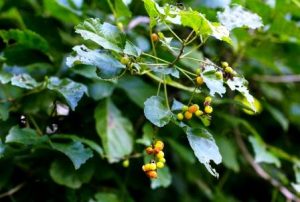
Allophylus africanus. Photo: Bart Wursten. Source: Flora of Zimbabwe
Returning along the path we came to a termitaria remarkable for the large number of Allophylus africanus growing on it and fruiting profusely, with yellow, orange and red spherical fruit. Anton Ellert observed however, that none carried viable seed. The spherical fruit will usually distinguish this tree from Rhus species with which Allophylus is often confused, being also trifoliate, as Rhus usually have flattened fruit. This is worth remembering as the “hairy armpits” of the vein axils of Allophylus, absent in Rhus, are not always obvious. Close to this anthill were also Pterocarpus rotundifolius, Dombeya rotundifolia, Strychnos spinosa, and Cassia singueana coming into flower. En route back to the bus, those who were still alert may have seen Strychnos cocculoides with its corky bark, Dichrostachys cinerea and Pavetta schumanniana.
After a leisurely lunch on Val’s well tended lawns, some of us stayed put, some looked around the kopje behind the house, but a good number of us walked a distance from the house to a boulder strewn area to see what, for me at least, was the highlight of the day, being Hymenodictyon floribundum, the fire bush, whose autumn leaves were giving a magnificent display of crimson and red. Ironically, considering the name, this tree is thin barked and therefore fire susceptible, which explains why it only survives amongst rocks and kopjes where fires cannot reach. This tree is a member of the RUBIACEAE family, along with Gardenia, Vangueria and the coffee species. Hymenodictyon demonstrated its kinship by its easily visible interpetiolar stipules.
In the same area we found, for the second month in succession, Monotes engleri. It was observed that we seem to be seeing this close relative of M. glaber more frequently on our outings. On reflection however, it seems likely that this is because we have become more alive to its identifying features than in the past when we may not have recognized it because it is so similar in general appearance to Parinari curatellifolia especially if no fruit are present. The main reason for this similarity is that like Parinari it has a dark upper surface and pale lower surface on its leaf which is also simple and of comparable size. However, the give aways are the extra floral nectary at the base of the leaf and the characteristic fruit, very similar to that of M. glaber which we also saw.
In this same area and deserving of a special mention were several fine specimens of Brachystegia glaucescens.
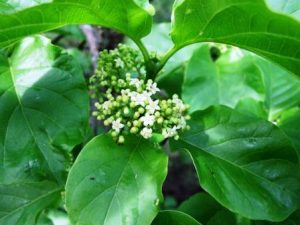
Canthium lactescens. Photo: Rob Burrett. Source: Flora of Zimbabwe
Coming to the banks of another stream a small Canthium lactescens (also RUBIACEAE) was seen. Judy Reed demonstrated where its ‘milk’ comes from. If the terminal bud is squeezed or its stipules opened up a thick sticky ‘milk’ can be detected or squeezed out. Hence the name.
After the long trudge back to the homestead we heartily enjoyed a lovely tea laid on by our hostess.
As the bus pulled out of the yard we saw from the windows Dodonea viscosa, Terminalia stenostachya, Pterolobium stellatum and sprays of the lovely creeper Clematis brachiata, know commonly s traveller’s joy and later, when in seed as ‘shock headed Peter’.
And what a joy it was to travel to Caledonia Farm to see a lovely area and enjoy such warm hospitality from our hosts. Thank you Bob and Val.
-Phil Haxen
MATABELELAND BRANCH
Sunday May 1st : Fortune’s Gate. Meet at the corner of Fortune’s Gate and Essexvale Roads at 0830 hours.
Sunday June 5th : Good Hope Farm. Meat at Eastlea at 0830 hours.
I was a great pleasure to have with us, on Sunday April 17th, Wendy Bullock who was visiting Bulawayo from her home at Chimanimani. We went once again to Charles Sykes ‘country’ at Richmond, because our previous outing there had been so successful. Much of the time was spent in trying to sort out the various species of Rhus, a most baffling family which always causes much discussion and argument.
The area contains a large number of Commiphora mossambicensis and they were at various stages, some completely bare, some still covered with bright yellow autumn leaves and some still green. The area has been much cut out, being adjacent to the Western Areas, and there was plenty of opportunity to study the variation in leaves between new and more mature growth.
-Dora Webb
ROOT NOTE Now that the responsibility for producing this Newsletter has fallen on my shoulders I would like to appeal for help, help by way of filling the newsletter with short articles of interest on any tree or bush related subject; or , say, ‘letters to the editor’ suggesting, criticizing, suggesting venues for outings, informing and generally providing a forum for debate. It should be remembered that Tree Life is a regular monthly publication and as such can be used by members and the branches to advertise events, or say, ‘wanted’ or ‘for sale’ items. This facility is available to please drop us a line, not just because I am lazy, but because this will make for two way communication between the Society and members and vice versa.
-Phil Haxen Chairman


